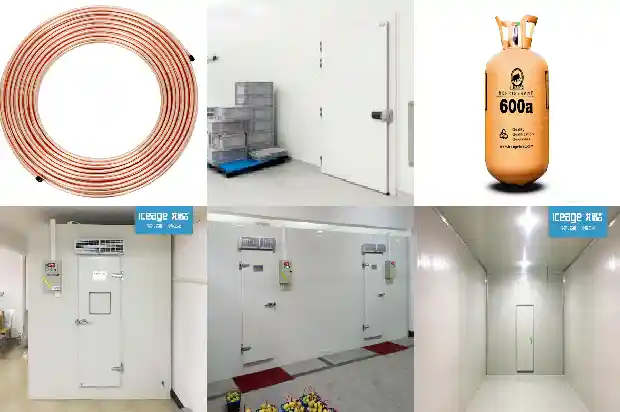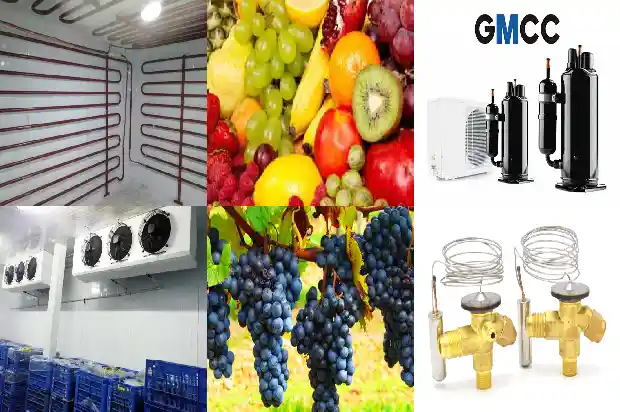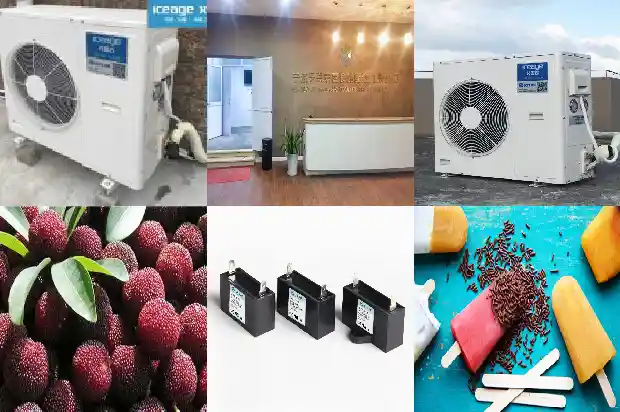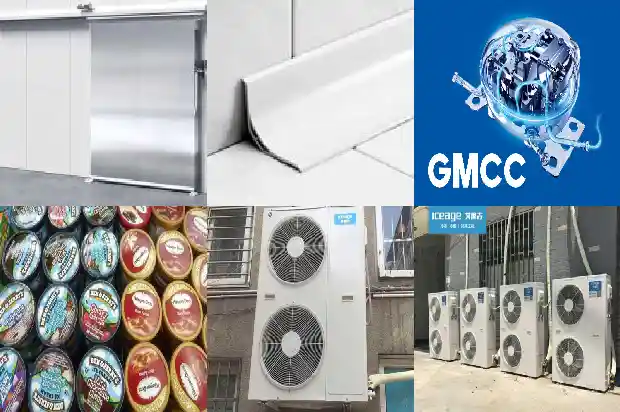Why Can Air - Source Heat Pumps Be Damaged by Freezing? How to Prevent Freezing in Winter?
2024-12-20
Causes of Freezing and Cracking of the Unit
Through the above case, the first thing we should clarify is which reasons are likely to cause the unit to freeze and crack. There are mainly the following three reasons.
- Long-term power failure of the unit
When the temperature is lower than ~5°C, if the power failure lasts for more than 4 hours, it is very likely to cause the heat exchanger to freeze and crack. In particular, when both the fluorine circuit system and the water circuit system are frozen at the same time, and the compressor restarts after power is restored, the compressor will directly suck the water in the external water circuit into the fluorine system, resulting in the scrapping of the entire unit. Therefore, when it is judged that there may be a long-term power failure, the water in the unit, water pump, and outdoor pipelines should be completely drained to prevent the unit from being damaged by freezing. - The main board of the unit is designed without an anti-freezing protection function
When the temperature is lower than 0°C, as long as the unit is in a powered-on state, regardless of whether the unit is in an operating state or whether it reports a fault code, the unit will automatically supply power to the circulating pump for 10 to 15 seconds every 30 minutes, allowing the hot water in the water tank to circulate between the water tank and the main unit. Use the hot water in the water tank to heat the valves, pipes, water pumps, and the heat exchanger of the unit to prevent freezing and cracking.
However, the machine designs of each manufacturer are different. Some machine main boards do not have an anti-freezing protection function. Once a failure occurs, it may cause the heat exchange sleeve to freeze and crack. - No water flow switch is installed or the water flow switch is short-circuited during cooling in summer, and at the same time, the temperature probe is inaccurate in measuring temperature!
When the air source heat pump is used for cooling in summer, the unit stops working when the water temperature is between 0°C and 10°C, and starts working when it is higher than 15°C. If the water temperature probe is inaccurate in measuring the water temperature, for example, when the water temperature has reached 0°C, but the probe shows that the temperature is still 25°C (higher than 15°C), then the machine will judge that the water temperature has not reached the temperature at which it needs to stop, and will continue to cool. At this time, if no water flow switch is installed or the water flow switch is short-circuited, it is very likely to cause the unit to freeze and crack.
Anti-freezing Measures for Air Source Heat Pumps in Winter
Currently, the northern region has entered a new heating period. As the temperature drops, ensuring heating has become a top priority. Whether it is an already installed heat pump or a project that is being installed, attention should be paid to the winter anti-freezing matters of air source heat pump units! Specifically, it can be carried out from the following aspects.
Currently, the northern region has entered a new heating period. As the temperature drops, ensuring heating has become a top priority. Whether it is an already installed heat pump or a project that is being installed, attention should be paid to the winter anti-freezing matters of air source heat pump units! Specifically, it can be carried out from the following aspects.
- Strengthen the insulation effect of pipelines
Pipeline insulation is very important. Exposed water pipes will cool down as the external environmental temperature drops. Those that have not insulated the pipelines before should put "clothes" on the pipelines as soon as possible. Only when the pipelines are insulated will the water in them not drop in temperature too much or too quickly.
For the pipeline insulation of air source heat pump heating, B1 grade with a thickness of 30 mm can be used outdoors, and B1 grade with a thickness of 20 mm can be used indoors (black). The outer layer of outdoor insulation uses aluminum sheet, and the outer layer of indoor insulation uses white cable ties for binding to make it look beautiful. The pipeline valves and bends must be well insulated, and there should be no exposed points of the pipeline.
When the heating pipeline passes through the pipe section in the outdoor yard of farmers, an insulation layer needs to be set. Before the pipeline insulation operation, a comprehensive inspection should be carried out on the distance between the pipeline and the wall, other pipelines, and equipment. If it is found that the insulation position is insufficient, rectification should be carried out if necessary. When connecting the pipe sleeves, insulation glue must be applied to the end faces (circumferential seams) of the pipe sleeves. The longitudinal seams of the pipe sleeves are required to be staggered, and generally, the longitudinal seams should not be vertically downward. The joints between the pipe sleeves are sealed with glue. When connecting the pipe sleeves with the main unit and the wall, insulation glue must be applied to the end faces of the pipe sleeves, the main unit, and the wall respectively for tightening. - Do not cut off the power of the unit
The air source heat pump heating of the water system uses water as an intermediate medium for heat transfer. Normally, the equipment has an anti-freezing function. When the water temperature drops to a certain level, the equipment will automatically start to prevent the equipment and pipelines from freezing.
If the weather temperature is relatively low, once we cut off the power of the air source heat pump when we go out, it may cause the water temperature in the pipeline to drop sharply. If the temperature is too low, it may damage the equipment and cause the equipment to malfunction. Therefore, when the heat pump unit does not operate for a long time, such as frequent power outages, the unit is shut down at night, during winter vacations, or when the unit is not frequently used in winter, the water in the unit, water pump, and outdoor pipelines should be completely drained to prevent the unit from being damaged by freezing. - Condensate water should be properly handled
During the heating process of the air source heat pump, a large amount of condensate water will be discharged. If there is a slight negligence in the discharge of condensate water, the condensate water will flow out through the pipeline and onto the ground. If the temperature is lower than zero degrees, the condensate water is easy to freeze into ice, which may freeze the drain pipe and then climb up along the drain pipe, finally resulting in the equipment being unable to operate normally. Therefore, the condensate water should be regularly cleaned.
Therefore, the position of the condensate water pipeline must be reasonably designed. First, the installation position of the main unit can be raised. Under normal circumstances, the height of the main unit from the ground should be not less than 30 cm. For areas with severe snow and ice, it is recommended to be at least 50 cm or more. Second, a heating cable can be added to the chassis of the main unit to defrost and deice. Third, a heating cable can be wrapped around the outer wall of the condensate water or defrost water drainage pipeline to prevent freezing.

- Install three-way pipes at the water inlet and outlet and install drain valves
During installation, drain valves and drain pipes should be installed at the lowest point of the water system. Even if it is not at the lowest point of the unit, drain valves should also be added to the unit's inlet and outlet. When encountering a power outage for more than two hours or when it is necessary to shut down the unit for a long time, such as when going out for a long time and the unit is not frequently used, open the drain valves at the water inlet and outlet to drain the rainwater in the main unit's water pump to prevent freezing and cracking after the temperature drops, and cut off the power supply. Then, when operating again, a comprehensive inspection of the air source heat pump system should be carried out to ensure that there are no failures. - Add ethanol alcohol to the system aqueous solution
Add ethanol alcohol with a concentration of more than 90% or more than 95% to increase the anti-freezing property. The amount of addition depends on the local minimum temperature. For example, adding 1 kg of alcohol to 100 liters of water capacity, its anti-freezing index is ~1°C, and adding 5 kg of alcohol, the anti-freezing index is ~5°C. When using ethanol added to the system for anti-freezing, it should be noted that the dosage should not exceed 40% of the total water volume of the system.
In addition, ethanol also has a defect that it has relatively strong volatility. When the exhaust valve is installed in a relatively closed space, it is easy to cause the ethanol content in the space to exceed the standard. If an open flame is encountered, it may lead to a fire. Moreover, due to the relatively strong volatility of ethanol, it is necessary to continue adding it after one or two years of use to maintain the original anti-freezing performance. - Add antifreeze to the system
For example, use antifreeze with a freezing point of ~15°C or ~25°C. However, due to the relatively high price of antifreeze, it will increase the initial investment cost. When using antifreeze, it must be noted that cheap antifreeze, such as antifreeze blended with methanol, should not be used, as it is corrosive to pipelines and will cause relatively large damage to valves, pipe fittings, water pumps, and unit heat exchangers. - Timely clean up the sundries and snow around the heat pump
If the installation position of the heat pump has poor ventilation, it will affect the heating effect of the heat pump. Therefore, it is necessary to clean it up more often. It should also be noted that the cold wind is blown out by the main unit's fan. If there are sundries blocking in front, it will affect the dissipation of the cold wind, which will lead to insufficient heat in the air and affect the heating effect. If the snow is too heavy, the snow should be cleared in time. - Add heating cables to the tap water pipes
In engineering applications, it has been found that some units are damaged by freezing after a power outage because the inlet pipe of the tap water for the outdoor unit freezes, resulting in the unit being unable to supply water and the water pressure switch of the unit being activated for protection. Then the water pipe starts to freeze, thus damaging the equipment. The solution is to wind an electric heating cable (for heating) around the periphery of the tap water inlet pipe of the air source heat pump unit, and then wrap it with insulation cotton. It is controlled by a separate switch. When the environmental temperature is lower than 3°C, the heating cable starts to heat. Generally, the heating cable has a temperature-limiting control and stops heating when it reaches a certain temperature.

Related Articles
- Influence of Fin Spacing of Evaporator in Air Cooler on Frost Formation
- Air - side Economizer
- Winter Approaches: How to Solve the Low High - pressure Issue of Air - cooled Condensing Units?
- What Are the Common Causes of Cold Air Blower Noise?
- How to Troubleshoot and Repair High - pressure Protection of Air - cooled Units?
- What Exactly Are the Ten Typical Malfunctions of Air Conditioners?
- What Misconceptions Should Be Avoided in Low - temperature Refrigeration System Repairs
- Practical Knowledge on Freeze Protection of Air - conditioning Equipment
- Remember! 3 Steps to Calculate Central Air - conditioner Cooling Capacity
- How to Read the High - and Low - Pressure Gauges of Refrigeration Air - conditioners?
- Analysis of Seven Reasons for Ice Formation in Computer Room Air Conditioners
- Air - conditioner Low - pressure Alarm? These Nine Common Causes
- Selection of Bypass Control Valves for Air - conditioning Water Systems
- Common Faults and Solutions of Central Air - conditioning Chiller Units
- Could a Tiny Copper Tube Cause a Multi - split Air Conditioner to Stop Cooling? Refrigeration Workers Must Pay Attention!
- Maintenance Techniques for Air - conditioning Refrigeration Systems
- Considerations in Selecting Packaged Air Conditioners and Their Heat Recovery Operations
- Characteristics and Differences among Water System, Air System and Refrigerant System
